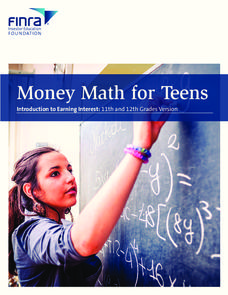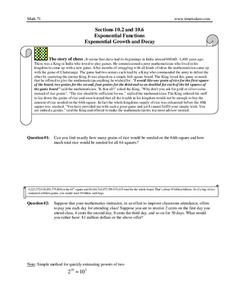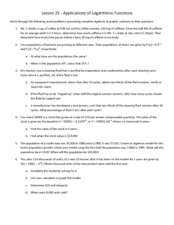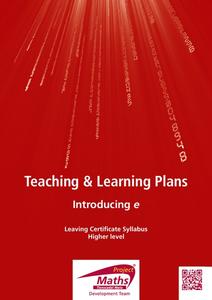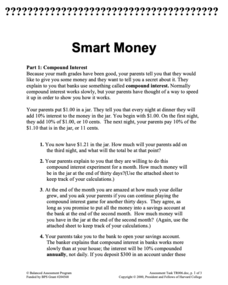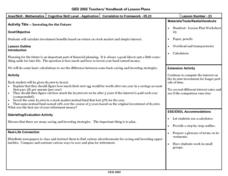SaveandInvest.org
Introduction to Earning Interest: Grades 9-10
Does your bank pay you for allowing them to hold your money? The lesson covers three different ways your money can make money. Topics include certificates of deposit, statement savings accounts, and money market accounts.
SaveandInvest.org
Introduction to Earning Interest: Grades 11-12
Does your bank pay you for allowing them to hold your money? Class members investigate three different ways money can make more money. Topics include certificates of deposit, statement savings accounts, and money market accounts. This...
Curated OER
A Valuable Quarter
Your young bankers model an account balance with an exponential function and solve the equation by extracting a root or taking a logarithm. The task involves the context of annual and compounding interest as well as some interesting...
Mt. San Antonio Collage
Exponential Growth and Decay
Start with the basics and move up the exponential ladder to master a variety of problem-solving and application problems. The problems are heavy on exponential growth and decay, compound interest, and natural log.
Curated OER
Introduction to Earning Interest: What are APR and APY?
Pupils explore saving and investing money. In this middle school personal finance lesson, students define and use investment vocabulary, explore compound interest and its effect of savings, and compute simple and compound interest. ...
Curated OER
A Lifetime of Savings
Sometimes people who seem to lead what would be considered an ordinary life do extraordinary things. Such was the case with Oseola McCarty, who donated a large sum of money for a university scholarship fund in her name. Oseala lived her...
Curated OER
MAT 106: Worksheet #9: Interest
In this interest worksheet, students determine the amount of compound interest paid on a loan, interest earned on investments, and balance at the end of a given period of time. This worksheet contains two real-world problems.
Curated OER
Pre-calculus Unit 3 Test 2
Students will solve exponential function problems, graph exponential functions, find the value of logarithms, determine future value, and compound interest. In this Pre-calculus lesson, students will use the properties of logs to solve...
Curated OER
Lesson 25 - Applications of Logarithmic Functions
in this applications of logarithmic functions worksheet, students solve 11 short answer problems. Students use logarithms to find half lives, compound interest, and population growth given a word problem.
Federal Reserve Bank
Savvy Savers
What are the benefits and risks of saving in an interest-bearing account? Pupils explore concepts like risk-reward relationship and the rule of 72, as well as practice calculating compound interest, developing important personal finance...
Curated OER
Compound Interest
Pupils analyze the variables in the formula of a compound interest. They model the increase or decrease of an investment using compound interest and discuss different compounding periods.
Curated OER
Interesting Interest Rates
Your young bankers compare earning interest accumulated yearly and monthly to decide which method most increases their balance. Using an exponential function to model the bank balance affords the learners more practice connecting these...
Curated OER
How Credit Card Interest Works
Students experiment with an Excel spreadsheet model that demonstrates the effects of interest on payments. They calculate actual costs, interest paid, and time necessary to pay off credit purchases and draw conclusions about the...
Project Maths
Introduction to e
First there was pi and now there's e. A discovery-based lesson plan helps learners find a pattern in compound interest as the compounding period changes. Their investigation results in the discovery of the number e. The lesson plan is...
Curated OER
The Business of Interest
Students explore the concept of simple and compound interest. In this interest lesson plan, students discuss how interest works on a loan. Students calculate simple and compound interest on loans of fictitious characters from a video.
Curated OER
The Bank Account
Your algebra learners become bankers for a day as they explore compounding interest and the formula used to calculate the balance in a savings account. Questions guide the learners as they analyze the formula's parts and their connection...
Curated OER
Thirty Exponential Application Problems
In this exponential worksheet, students solve thirty application problems. These problems cover compound interest, continuously compounded interest, and exponential growth models.
Curated OER
Logarithm Word Problems
In this logarithm activity, 8th graders solve 10 different word problems related to various logarithms. First, they determine the amount of compounded interest that will be in an account after a number of years. Then, students determine...
Curated OER
Chapter 12 - Objective 5.1 Formula Problems
In this formula activity, learners read short story problems and determine the correct formula. They compute compound interest, use the Richter equation to figure magnitude and find the pH of given solutions. This one-page activity...
Council for Economic Education
A Penny Saved
A penny saved is a penny earned! Scholars research the different ways to save money over a lifetime. They investigate the Rule of 72, compound interest, and sub-prime loans to gain an understanding of how banks aid in the saving process....
Concord Consortium
Smart Money
Watch the money grow daily. Scholars tackle a problem to determine how much money they will have if a dollar grows at 10 percent compounded daily after a month. Using that knowledge, learners notice the difference between varying savings...
Curated OER
Compound Interest and Quiz on Logs
Students discuss how money accumulates interest. In this calculus lesson, students discuss compund interest based on years of investing the money. They discuss rate per period, principal and number of periods.
Curated OER
Credit Cards and Compound Interests-Exponential Growth
Eleventh graders investigate the way credit cards work when collecting interest. In this algebra lesson, 11th graders investigate the growth of interest exponentially when using a credit card. They calculate what the cheapest rate is to...
Curated OER
Investing for the Future
Twelfth graders perform basic calculations for saving and investment strategies. they simulate the investment of $1,000 in the stock market and savings account. they determine which pays the greater dividend.
Other popular searches
- Simple and Compound Interest
- Simple Compound Interest
- Compound Interest Projects
- Compound Interest Recursion
- Compound Interest Worksheets
- Money Compound Interest
- Sinple and Compound Interest
- Compound Interest Retirement
- Interest Compound
- Money + Compound Interest
- Compound Interest Formulas
- Compound Interest/worksheet



